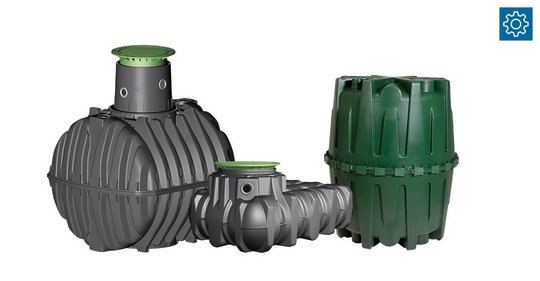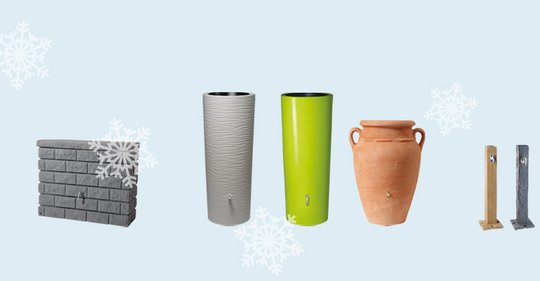Watch out for winter - how to make your garden frost-proof!
Winter is approaching, and is your garden still in 'summer mode'? Then you should start preparing for winter now, before the big frost comes! But don't worry: the most important work can be done quickly. Even with irrigation systems and rain barrels.
Rain barrels and irrigation systems
There's nothing quite like a mnemonic: "From east to east, i.e. from Easter to October, it's generally completely safe to drive with a full rain barrel," says our product manager Marcus Seyfried. "It only becomes dangerous when temperatures drop well below zero at night." Above-ground plastic rain barrels must therefore be emptied before the frost period. If they remain full, they can leak or, in the worst case, burst. However, a few simple steps are all it takes:
- Stop the inflow of fresh rainwater. For example, if you have a downpipe filter with a summer/winter function (our downpipe filters are equipped with this, for example), this means that you simply set it to winter. If your filter does not have this function or you use a different method to collect the rainwater, disconnect the connection to the downpipe or cover the barrel with a lid.
- Open the tap and empty the container. You can then simply leave the tap open for the winter.
- Drain or empty the remaining rainwater. Our rainwater containers, for example, have an additional outlet opening for this purpose. This is usually located at the bottom of rain barrels and on the side of other containers, but always significantly further down than the tap.
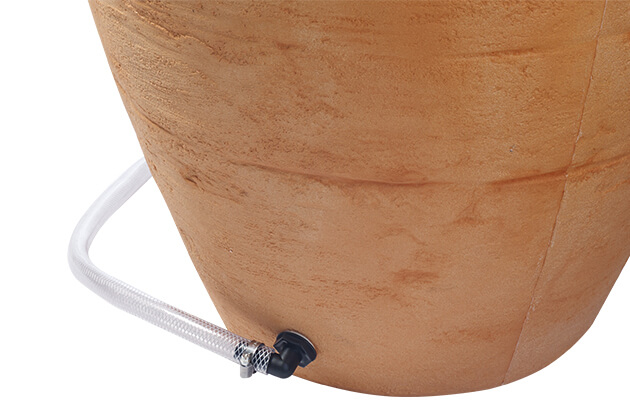
4. if you have not already done so, fit a wind safety device. The water in the barrel normally ensures that it is stable. When the water is drained, particularly high and narrow rainwater containers need a wind safety device. "With us, the wind protection is included in the scope of supply," says Product Manager Seyfried. As the safety device is bolted to the wall and the container, it reliably protects the garbage can from tipping over and therefore also from scratches - even when a strong wind blows. Additional information for users who do not have a downpipe filter with a summer/winter function. We should also mention here that all GRAF downpipe filters have a summer/winter function.
Why the water has to go out
Why does the rainwater have to come out at all and then almost completely? Isn't it enough to leave a little space at the top so that it can expand when it freezes? "No," emphasizes Seyfried, "freezing large quantities of water in the container would have a certain explosive force, similar to a closed water bottle - that's simple physics," says Seyfried. A residual amount of 2-3 centimeters does not matter, but the water simply cannot be allowed to stand up to the drain tap or higher. The "winter-proof" rating that some manufacturers give to their products only ever refers to the material of the barrel itself, not to its resistance to freezing water. "There is no solution on the market that can permanently withstand when water turns to ice and expands," explains the expert.
Cistern: the true winter-proof solution
The only rainwater tank that is truly winter-proof is therefore an underground one, i.e. a cistern at a frost-free depth of around 60 to 80 centimeters below ground. This allows the water to run even in winter. However, the water or pipes must be laid exclusively in the frost-free area, i.e. also 60 to 80 centimeters underground or through the house. Otherwise, the same applies to the cistern:
- Empty all tapping points that are not in a frost-free area (e.g. water socket or tap)
- Switch off the submersible pump power supply
The water may remain in the tank and further rainwater may also flow in. This is the difference to an above-ground rainwater tank.
If you own a rainwater tank, you have an easy time just before winter.
However, care should be taken with irrigation systems connected to the rainwater harvesting system, such as pop-up sprinklers or drip irrigation. These must also be emptied in winter. They should be well blown out with a compressor. A good time for this would be mid-October, when the nights are already sufficiently humid so that little or no watering is required in the garden.
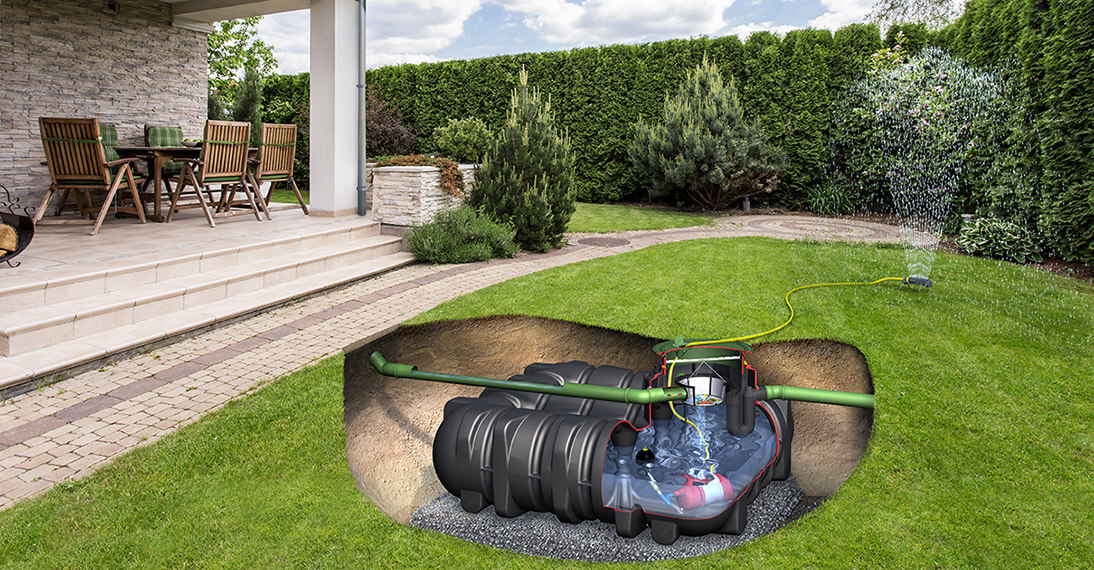
Sensitive plants
Of course, it is also important to look after the plants. Quickly move non-hardy plants that are still in pots and tubs in the garden or on the patio indoors. They will survive the winter best in a bright, cool room, not in a warm kitchen or heated living room. A different schedule is required for sensitive plants in beds: It is best to cover them for the winter. Fleece or fir branches are suitable for this. Mulch around them creates a protective environment on the ground.
Lawn and leaves
The lawn should be mowed as late as possible before the cold days. Because if it warms up again afterward, the lawn will continue to grow. However, the exact day is not important, because: It is much more important for the lawn that you clear it of leaves. Leaves damage the grass if they are left lying around and start to rot and mold underneath. It is best for the world of small animals such as spiders and insects, but also for the plants themselves, if the leaf vacuum is left in the shed. Instead, it is better to use a rake or leaf broom. Where the collected leaves are good for: "You can sweep them under hedges and between bushes and spread them on flower beds," says NABU expert Marja Rottleb in press articles as a tip. "This is not only good frost protection, but also a habitat for hedgehogs, various insects, mice and reptiles."
Garden furniture
Most of today's modern garden furniture is winterproof and can even withstand snow. However, if you have enough space, we recommend storing it in a sheltered place over the winter. This will protect them from UV radiation and severe frost, which will extend the life of your garden furniture.
Repainting the garden?
Of course you can replant your garden or flower beds. However, experts no longer agree on whether or not this is a good idea. Some say that digging up the soil upsets the sensitive microorganisms in the soil. Others see precisely this as an advantage. In very firm, loamy soils, however, it still has an advantage: the thick clods of earth are broken up by the frost, making the soil finer.
Shrubs, perennials, flowers
You can also take care of shrubs, perennials and faded flowers before winter. Depending on the species, these can be pruned or removed. If you want to keep your garden absolutely tidy, you can do this before the cold weather arrives. However, those who prefer to leave this part of the work until later may even have better reasons for doing so: After all, anything that is left standing even now provides shelter for insects and food for the birds in winter.
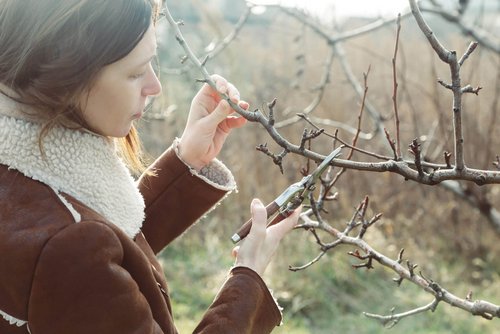
Pond
If you haven't already winterized your pond, now is the time to do it. Cutting back the pond plants reduces the formation of algae. To prevent a complete layer of ice forming over the pond, there are so-called ice-free holders that can be placed on the surface of the water. This prevents the pond from freezing over completely or an excessively high concentration of putrefactive gases. However, the most important thing to do before the frost is
- Empty and dry the pond filter.
- Remove the pump and place it in a bucket of water so that the seals do not become porous over the winter. Store in a frost-free place.
The clever gardener plants ahead?
By the way: If you still have time to plan ahead for spring, you can still make use of the residual warmth in the soil that will be missing in spring. Woody plants, trees, shrubs and selected perennials can already be planted now.


